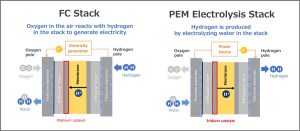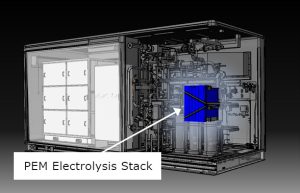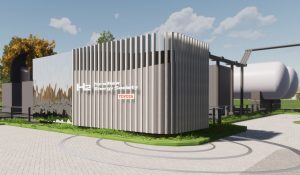Toyota uses hydrogen technology to accelerate factory decarbonisation
Toyota Motor Corporation (Toyota) is working with industry partners to use hydrogen and renewable energy to decarbonise factories. It has recently developed new electrolysing equipment that produces hydrogen from water, using the fuel cell stack and other technologies from the Mirai fuel cell electric saloon.
This equipment will be put into operation during March in a DENSO plant in Japan and will serve as a working demonstration designed to help promote its wider uptake in the future. Toyota is accelerating its work with Japan’s Fukushima prefecture to develop future cities, building a model for local hydrogen production and consumption. Using electrolysis equipment produces clean hydrogen that can be burned in one of the DENSO plant’s gas furnaces.
Toyota has positioned hydrogen as a critical fuel for initiatives aimed at reducing CO2 emissions and contributing to the drive towards carbon neutrality. It is promoting hydrogen use not only through fuel cell electric vehicles (FCEVs), including passenger cars, trucks and buses, but also through the use of fuel cell (FC) products, such as stationary generators. To this end, it is working with industry partners in areas of hydrogen production, transportation, storage and usage.
Toyota itself is using hydrogen for FCEVs, stationary generators and production purposes. It has also promoted other activities such as the development and manufacture of FC trucks to transport hydrogen. In the future, it hopes to contribute to expanding the options for hydrogen production, using biogas generated from livestock manure, in addition to developing electrolysis equipment.
Electrolysis equipment features
The electrolysis equipment has been newly developed, using the FC stack featured in Toyota’s Mirai saloon and Sora FC bus. It benefits from both the technology Toyota has cultivated over many years of FCEV development and the knowledge and expertise it has accumulated from the technology’s use in different working environments worldwide.
Its key features are: –
- The cells in the Proton Exchange Membrane (PEM) electrolysis stack are highly reliable, backed by the mass production and usage results from more than seven million (enough for approximately 20,000 FCEVs) produced since the launch of the first Mirai in December 2014.
- Toyota uses titanium for the stack separator, developed to improve the durability required of electrolysis equipment. Titanium is highly resistant to corrosion, maintaining almost the same level of performance after 80,000 hours of operation.
- More than 90 per cent of the FC stack components used for FCEVs and FC stack production facilities can be used or shared in the production process for PEM electrolysis stacks. This allows mass production at a cost level that can enable widespread use. Furthermore, it significantly reduces the development period, using technology, knowledge and experience gained through many years of FCEV development.
Equipment overview
| Dimensions – length/width/height (m) | approx. 2.3/5.8/2.8 |
| Hydrogen production capacity (kg/hour) | approx. 8 |
| Hydrogen production energy (kWh/kg) | 53/1 |
| Stack type | Proton Exchange Membrane (PEM) |
Toyota will be exhibiting its FC stack used in the electrolysis equipment and other concepts at the FC Expo (International Hydrogen and Fuel Cell Expo) in Tokyo from 15 to 17 March. The hydrogen utilisation at DENSO Fukushima is being implemented as a project subsidised by the new Energy and Industrial Technology Development Organisation (NEDO).
ENDS




